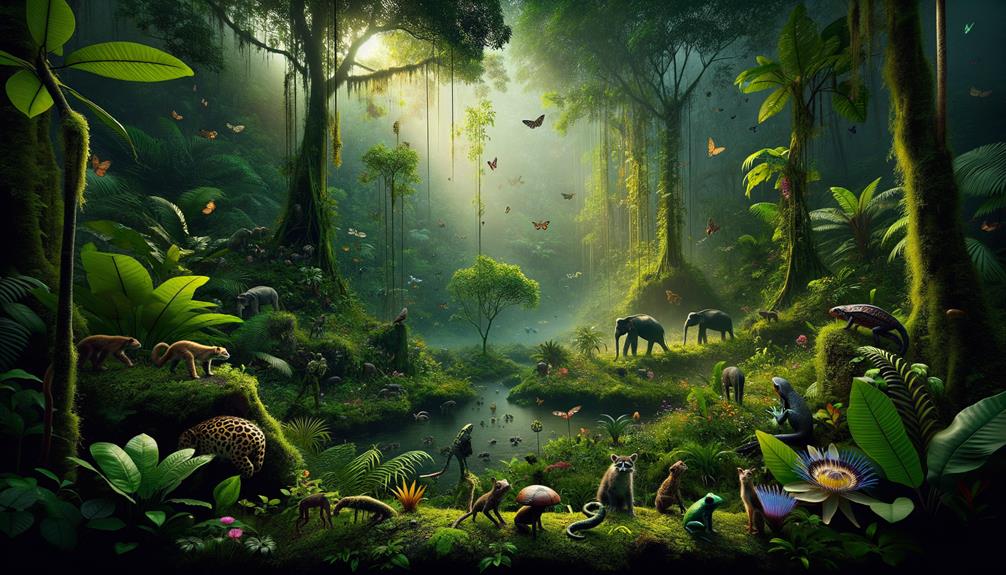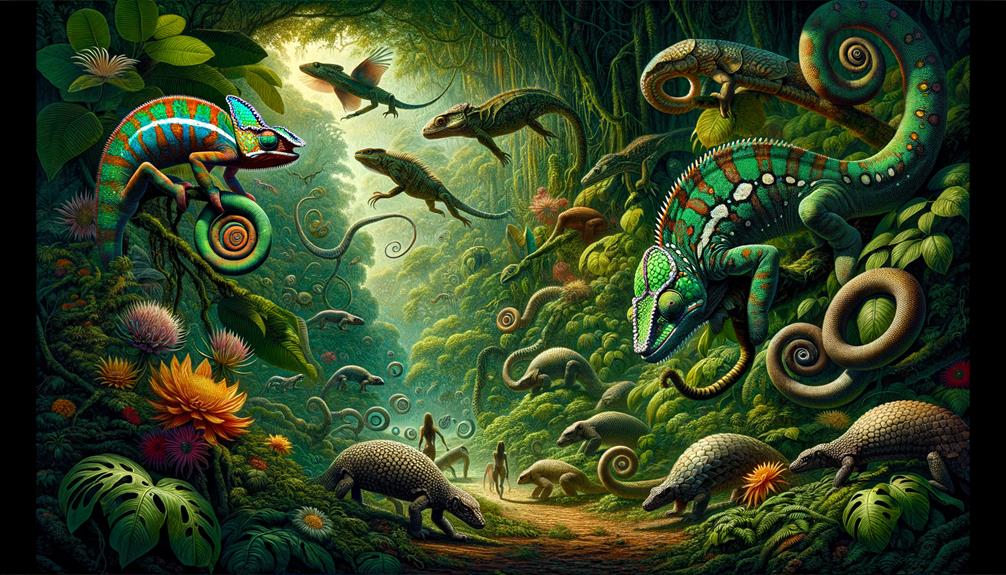In the Amazon rainforest, reptiles play a vital role in maintaining ecological balance. With over 450 species, including caimans and geckos, each one has a unique function in the ecosystem. Rare species like Enyalioides laticeps, Pseudogonatodes guianensis, and Tantilla melanocephala showcase the region's remarkable evolutionary achievements. However, deforestation, illegal trade, and climate change threaten their survival. Researchers at institutions like Fernando Alcántara Bocanegra are working to understand and protect these valuable species through field sampling and long-term monitoring. Let's take a closer look at their fascinating world and our efforts to preserve it.
Key Takeaways
The Amazon rainforest is a treasure trove of reptile diversity, boasting over 450 documented species. From caimans and anacondas to iguanas and geckos, these reptiles have adapted to occupy various niches within the Amazon. Rare and endemic species, such as Enyalioides laticeps, highlight the region's unique evolutionary processes. However, these species face threats like habitat loss and illegal wildlife trade, making conservation efforts crucial. To address these concerns, research centers in the Amazon conduct long-term studies to understand and conserve reptile biodiversity.
Importance of Herpetofauna
Herpetofauna, the collective term for reptiles and amphibians, play a vital role in maintaining the ecological balance of the Amazon rainforest. I've always been fascinated by how these creatures contribute to the Amazon's astounding biodiversity. Their presence is a clear indicator of the environmental health of this vast ecosystem. Through my research, I've learned that reptiles like snakes, lizards, and turtles are not just inhabitants but crucial components of food webs, controlling insect populations and serving as prey for larger animals.
Protecting these species is crucial. Without them, the delicate balance of the Amazon could be disrupted, leading to far-reaching consequences for other forms of wildlife. Each reptile species serves a unique function, and their loss could mean the collapse of certain ecological niches. It's not just about saving individual species but preserving the intricate web of life they support.
The Amazon rainforest, with its unparalleled biodiversity, offers a sanctuary for these remarkable creatures. By focusing on herpetofauna conservation, we're not only protecting reptiles but also ensuring the survival of countless other species that depend on them. The work we do in this field is vital, and it's something I'm deeply passionate about.
Reptile Species Diversity
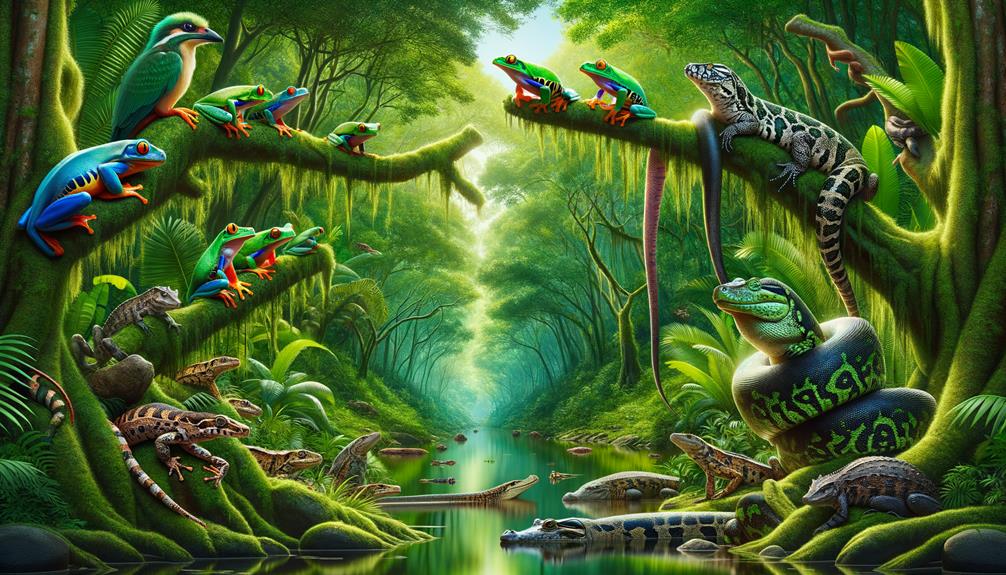
The Amazon rainforest is home to an astonishing array of reptiles, with over 450 documented species that contribute to its unparalleled biodiversity. Among these, caimans lurk in murky waters, anacondas slither through dense underbrush, iguanas bask in the canopy, and geckos cling to tree trunks. This rich variety of reptile species plays a crucial role in maintaining the ecological balance of this vast ecosystem.
Many of these reptiles are found only in the Amazon, highlighting the unique evolutionary processes that have shaped this habitat. The diversity within this habitat is a testament to millions of years of adaptation and survival. However, this delicate balance faces significant threats. Habitat loss due to deforestation, climate change altering the environment, and the illegal wildlife trade all pose severe risks to these species.
Preservation efforts are critical to ensure these reptiles continue to thrive. Understanding the intricate web of life these species represent is vital for their protection. By prioritizing conservation and addressing the impacts of habitat loss and climate change, we can help safeguard the Amazon's extraordinary reptile diversity for generations to come.
Rare and Endemic Reptiles
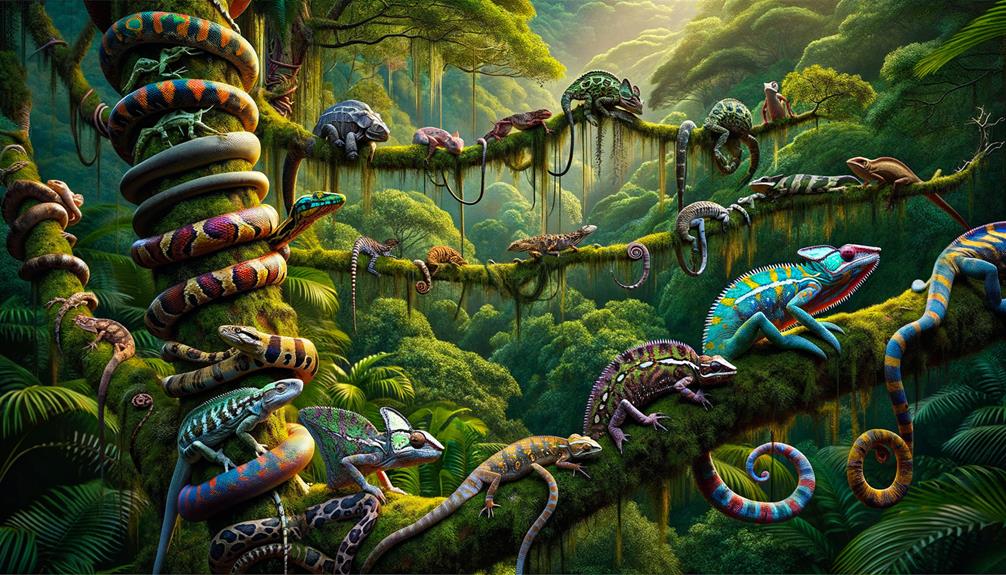
The Amazon rainforest is home to several rare and endemic reptile species, highlighting the region's extraordinary biodiversity and evolutionary uniqueness. The Enyalioides laticeps, a striking lizard native to the Peruvian Amazon, is one such species. Alongside the elusive Pseudogonatodes guianensis gecko and the venomous Tantilla melanocephala snake, these reptiles epitomize the diverse and specialized nature of Amazonian herpetofauna.
To better understand the diversity of reptiles in this region, consider the following species:
| Species Name | Habitat |
|---|---|
| Enyalioides laticeps | Peruvian Amazon |
| Pseudogonatodes guianensis | Select Amazon Basin regions |
| Tantilla melanocephala | Peruvian Amazon |
| Anolis bombiceps | Varzea forests |
| Bothrops brazili | Amazon Basin |
These reptiles and amphibians play a vital role in maintaining ecological balance. Unfortunately, many of these rare species face significant threats from habitat loss and fragmentation, driven primarily by deforestation. National Parks play a crucial role in the conservation of herpetofauna by providing protected habitats.
Preserving this rich diversity of reptiles is vital for the continued health of the Amazonian ecosystem. The unique adaptations and roles of these species underscore the need for targeted conservation efforts to safeguard Amazonian herpetofauna.
Conservation Challenges
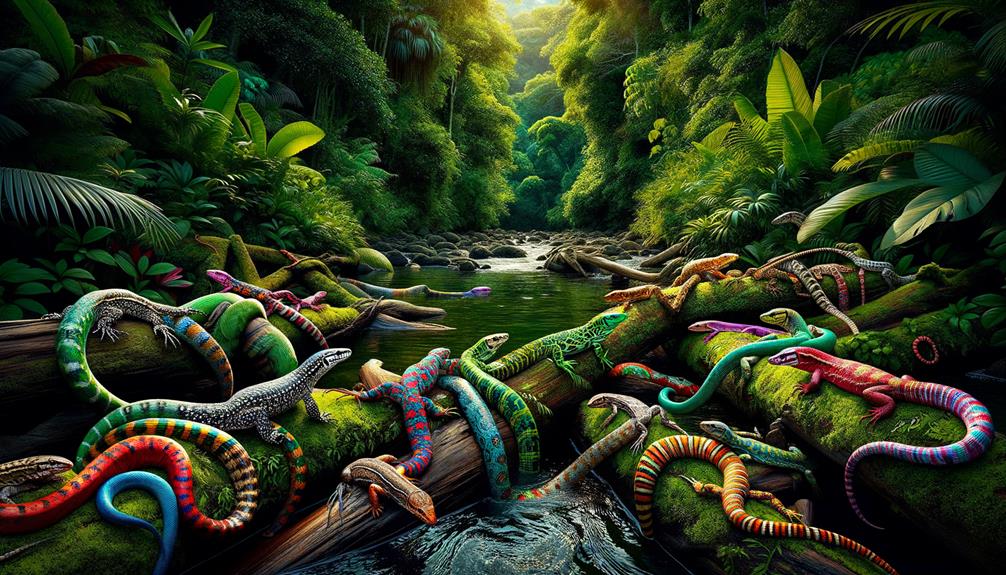
Conservation challenges in the Amazon are multifaceted, with habitat loss due to rampant deforestation posing one of the most significant threats to the survival of its unique reptile species. The relentless clearing of forests for agriculture and urban development causes land-use changes that fragment the habitats these reptiles depend on. These alterations not only shrink their living spaces but also disrupt the ecological balance.
The illegal wildlife trade exacerbates the problem, putting immense pressure on certain reptile populations. Species like turtles and caimans are often poached for their meat, shells, and skins, leading to alarming declines in their numbers. Climate change further complicates the situation, as temperature shifts can critically affect temperature-sensitive reptiles, impacting their reproductive success and survival rates.
Pollution, especially in aquatic habitats, adds another layer of threat. Contaminants from mining and agricultural runoff poison the water, harming both amphibians and reptiles. Effective conservation strategies are urgently needed, and they hinge on improved monitoring and research. By systematically tracking population trends and ecological impacts, we can develop targeted actions to mitigate these threats.
Addressing these challenges requires a coordinated effort, blending scientific insight with robust conservation policies to guarantee the Amazon's reptiles continue to thrive.
Current Research Efforts
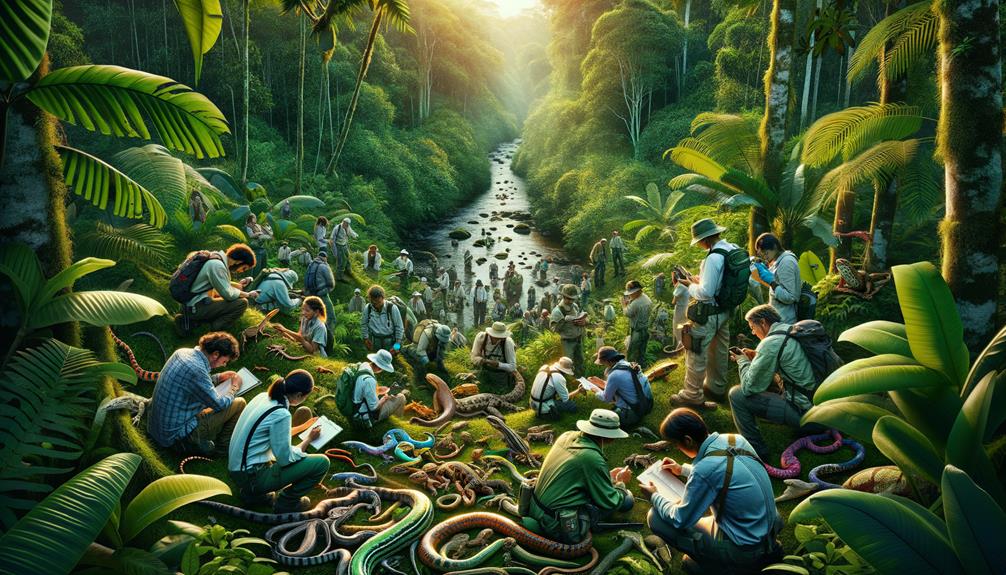
In the Iquitos region of Peru, researchers are working tirelessly to study and protect the diverse array of amphibians and reptiles. At the Fernando Alcántara Bocanegra Research Center (CIFAB), they're using field sampling techniques like transects and pitfall traps to capture and study these species. The white sand forest habitat is crucial for understanding species diversity and population trends.
The researchers meticulously photograph, genetically analyze, and preserve the specimens as part of the Biodiversity Reference Collection at the Peruvian Amazon Research Institute (IIAP). This thorough approach helps us gain a comprehensive understanding of herpetofauna in the region, supporting both research and conservation efforts. The dry season is the best time to visit and observe these activities, as the field conditions are ideal.
Long-term monitoring is vital for understanding the ecological roles and conservation needs of Amazonian reptiles and amphibians. By collaborating with local communities and organizations like the company for Inca Jungle expeditions, researchers can mark and protect required fields, promoting a sustainable coexistence between humans and wildlife.
Frequently Asked Questions
How Diverse Is the Amazon Rainforest?
The Amazon rainforest is a true marvel of ecological diversity. With over 40,000 plant species, 2,000 freshwater fish, and millions of insects, it's a testament to the incredible richness of life on our planet.
How Many Species of Reptiles Are There in the Amazon Rainforest?
The Amazon rainforest is home to over 400 species of reptiles, showcasing an incredible array of biodiversity. From anacondas to iguanas, each species thrives in its unique ecosystem, highlighting the urgent need to protect this precious natural resource.
Is the Amazon the Most Diverse Ecosystem?
With over 400 documented reptile species, the Amazon is a biodiversity hotspot. Its unique geology, varied habitats, and stable tropical climate create an ideal environment that supports an incredible array of life.
What Percent of the World's Biodiversity Is in the Amazon Rainforest?
I've always been fascinated by the Amazon rainforest. It's astounding to think that it's home to around 10% of the world's known species, despite covering a tiny fraction of the Earth's surface. This incredible ecosystem is a true natural wonder.


